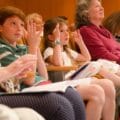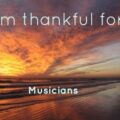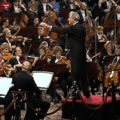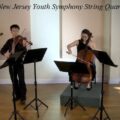Jan 18, 2017
Mr. Rose’s Question – Not To Be Confused With Mr. Holland’s Opus
Last March I blogged about a Charlie Rose interview with outgoing New York Philharmonic Music Director Alan Gilbert.
Below is the question posed to Maestro Gilbert that really captured my attention:
“Do we need more of that (programs like Leonard Bernstein’s Young People’s Concerts) to somehow heighten the experience of and the appetite for classical music?”
The short answer is ‘Yes!’ And the challenging follow-up questions are: How do we get their attention? And who exactly are ‘they?’ They are the 95% of the US population who could be profoundly moved by listening to classical music (if they could be coaxed to listen) for whom this prospect is off the radar. Perhaps no one has invited them to ‘dine here.’ Or perhaps the invitation has been posed in an off-putting way.
The Discovery Orchestra is on a mission to teach as many people as possible how to listen to classical music. We know how to do this, once people have wandered into our sphere. Our anecdotal and statistical responses for over two decades confirm that assertion.
The first step is to help people become aware of the difference between giving music our undivided attention and merely hearing it as background while we do other things or think other thoughts. Our society has been trained to actually ignore music. How? By the omnipresence of electronically reproduced music that functions as sonic wallpaper, surrounding virtually every activity in the industrialized world. The current love affair with multi-tasking has compounded the problem.
With a welcoming and humorous approach, The Discovery Orchestra enables people to experience an ‘aha’ around listening and hearing. Once that happens, we encourage the development of listening skills that go hand in hand with listening awareness. One such skill is noticing musical detail – starting simply, and eventually noticing as much detail as possible!
Another important skill, which we simultaneously help to develop, is lengthening the amount of time we can remain focused on music. . .increasing our musical attention spans. Remember, composers like Beethoven and Tchaikovsky composed with the assumption that we would give 5- to 10-minute chunks of our undivided attention to the wordless, abstract discourses of their movements – the ‘chapters’ of their symphonies, sonatas, etc. They were not writing background music for movies or TV commercials.
How do we take people on this learning journey? The critical word for our learning environment is ‘welcoming.’ The Discovery Orchestra creates both live concerts and electronic media programs for Public Television and YouTube that appeal to a large cross section of ages – programs that have proven effective with children as young as 9 and with adults in their 90s.
But how do we get everyone’s initial attention? How do we say ‘hello’? Do we drive down streets shouting through bullhorns: “Classical music can make you feel incredible. Come and get it!” Do we launch a massive social media campaign with irresistible images and words aimed at millennials? Do we hand out helium balloons to children in Times Square with the words: ‘Listen Better’ printed on them? All or none of these approaches?
The time for The Discovery Orchestra to answer this question is now. For this reason we have engaged The TASC Group, a boutique communications company based in New York City, to partner with us on a public education campaign throughout 2017 and 2018. More to come!








